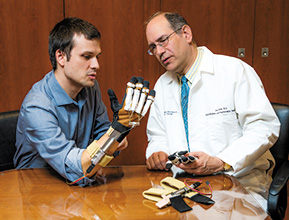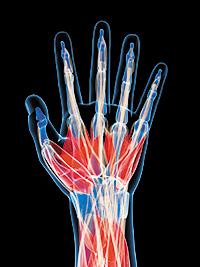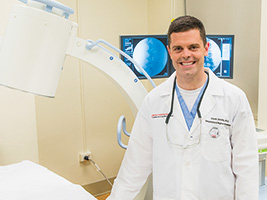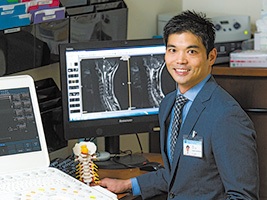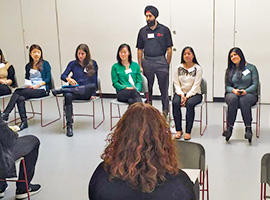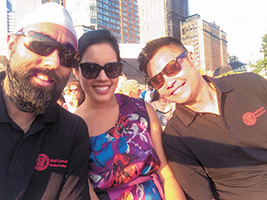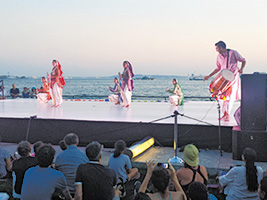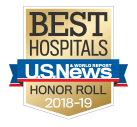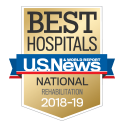|
||||||||||||||||||||||||||||||||||
Creating a Helping Hand for What a feat of engineering is the human hand, with its nimbly cooperative moving parts, minutely graduated tactile sense, and prehensile strength. This superbly designed structure can hold a pen or send a text, grip a bat or help change a tire, navigate a keyboard or hold an infant. But when a stroke blunts or obliterates communication between the hand and the brain, these discrete and vital skills are often shut down or severely curtailed. “The hand is such a marvelous piece of equipment,” says Matei T. Ciocarlie, PhD, a research scientist and robotocist on the Mechanical Engineering faculty of Columbia University. “It’s incredibly dexterous and versatile. It has more than 20 joints; those joints are controlled by more than 40 muscles – many of those in the forearm. In terms of versatility, the human hand is unmatched by any manipulator we can build in the artificial world. Whenever I hear someone remark, ‘There’s a beautiful sports car, a flat screen television, or some impressive piece of equipment, I always think that the human hand is one of the most impressive pieces of equipment that I know. Most of us are lucky enough to have two functioning hands, but once a hand is impaired, it is very hard to rehabilitate.” Almost three-quarters of the 800,000 new stroke victims per year in the United States will have upper limb impairment. About half of those respond to therapy, and most patients have some chronic level of impairment. “Therapies have been quite inadequate historically,” says Joel Stein, MD, Physiatrist-in-Chief, Department of Rehabilitation and Regenerative Medicine, NewYork-Presbyterian Hospital. “Therapy with a dedicated and knowledgeable therapist remains an essential part of a stroke patient’s recovery. But you need something that patients can also use on their own in the home environment, without direct clinical supervision, to really achieve a good result.” Dr. Stein and Dr. Ciocarlie pooled their respective rehabilitation and engineering experiences and expertise in what Dr. Stein describes as an ideal scenario for creating a device that could confront this challenge. “Our department enjoys a very strong and productive relationship with Columbia’s engineering school,” notes Dr. Stein. “So the collaboration with Dr. Ciocarlie from day one has been an effective strategy, enabling us to figure out what’s needed, how to best implement it, and to do that in an iterative process.”
“One of the strengths of the team is the combined rehabilitation and engineering perspective,” agrees Dr. Ciocarlie. “It’s a huge eye-opener for us as engineering researchers. When you build an assistive device in a lab, it looks reasonable, you try it on an able-bodied person, and it seems all right. Then when you go and try your device with a stroke patient under the guidance of an occupational therapist, you learn so much about the practical considerations and what it means for somebody who has an impairment to be able to put on, use, and then take off a device that you’ve built. Sometimes it’s simply a matter of an engineering refinement, but sometimes it’s the fundamental approach that you need to rethink in order for the device to actually work with the population that you’re hoping to help.” So Dr. Stein and Dr. Ciocarlie started working together on a concept for an orthosis that would be an intersection between technology and a need they saw in the world of stroke patients. “It’s a very hard problem – a combination of hardware and software, the body and the brain,” says Dr. Ciocarlie. “We’re constantly trying to build better hands, but also to discover the underlying mechanisms, the controllers, the planners that enable versatile manipulation.” “Dr. Ciocarlie’s particular interest is in the hand’s grasping capabilities, which is an area of particular concern to me in terms of rehabilitation,” says Dr. Stein. “We did not want a device that would be just a pure demonstration of principle. Our vision was to create a device a patient can use in a home environment and continue to practice with between appointments with the therapist.” The creation of such a device from an engineering perspective seemed very difficult, Dr. Stein admits. “We had two key research questions: Can a wearable device achieve the force and dexterity levels needed for versatile manipulation? Can a dexterous assistive device be intuitive to control for the patient?” Their collaboration produced MyHand, a prototype for a lightweight, tendon-driven orthosis for prehensile manipulation rehabilitation after stroke. In July 2015, after an initial proof of concept trial, Drs. Stein and Ciocarlie received a Columbia-Coulter Translational Research Partnership Award for Rehabilitation/Robotics that was quickly followed by a $600,000 development grant from the National Science Foundation. In March 2016, Dr. Ciocarlie won the prestigious Early Career Development Award from the National Science Foundation, which he will use to explore the science of manipulation.
“If you try to build a robot hand that is as intricate as the human hand, with 20 joints and as many motors,” says Dr. Ciocarlie, “that’s an extremely complex, fragile, and difficult-to-use piece of equipment.” But in Dr. Ciocarlie’s work in robotics with Peter K. Allen, PhD, in the Columbia Department of Computer Science, they discovered it was possible to think of artificial hands functioning in coordinated joint movement patterns. “You can have a lot fewer motors than joints if you actuate your joints according to these coordinated movement patterns,” explains Dr. Ciocarlie. “With this in mind, it became a question of designing hardware such that a single motor can stimulate multiple joints in a specific way. We believed it would make a significant difference from a rehabilitation perspective if we were able to build assistive robotic devices that helped people with manipulation tasks. But the key difference from current devices would be that the person doesn’t have to come to the clinic and get hooked up to a large desktop-sized machine that would move their fingers. Instead it would be a device that they could wear on their hand and forearm as they move around a familiar environment. And instead of sitting at a desk doing strengthening games, they could rehabilitate while actually engaging in activities of daily living.” In the MyHand project, Dr. Ciocarlie is not building a robot’s hand, but rather creating assistance for a human hand. He and his colleagues are using what he calls exotendons. “These are ‘tendons’ made of lightweight, flexible spectra wire, which extend over the surface of the hand,” explains Dr. Ciocarlie. “This network of tendons, routed on the outside of the human hand, uses many fewer motors than there are joints and fingers. A single motor is connected to a network of exotendons that cover multiple fingers and multiple joints.”
“We also need to figure out the right means of controlling the device,” adds Dr. Stein. “You don’t want to move the hand passively. How do you convert the intent to open the hand, for example, in a way that is therapeutic into a device that assists with that? We have a very specific set of ideas about how to make that connection so that when our patient says, ‘Okay, I’m opening my hand,’ the device actually assists at that moment when the patient wants to open their hand and not just on an automated basis.” Drs. Stein and Ciocarlie, along with engineering students and occupational therapists, are currently using two prototypes with a small number of stroke patients in limited pilot test studies to get a sense of how the paradigm works in terms of assisting with hand movement. “While the hand is an incredibly versatile and complex structure, there are certain patterns of movement that are quite common,” notes Dr. Stein. “And there are certain patterns of movement that are particularly difficult in stroke. Many stroke survivors have difficulty with opening their hand but can close it much more easily. So a device that allows patients to close their hand without interference, but assists with opening their hand would be a very appealing approach.” The overall goal of this groundbreaking device is to enable patients to continue meaningful exercises outside the hospital. “Training in the real world provides a functional context and is therefore likely to be more effective and of genuine meaning to the stroke survivor,” says Dr. Stein. “Our short-term goal is to have a device in about a year’s time that is able to do the basic functions of grasping and release, and then within a few more years to develop all the other functionalities.”
Rehabilitation Medicine Plays Major Role in New Spine Hospital
NewYork-Presbyterian has taken spine care to a new level with the launch of a comprehensive spine health initiative, including the establishment of The Spine Hospital at NewYork-Presbyterian/The Allen Hospital last summer. Playing a key role in this major endeavor, which brings together surgical and nonsurgical disciplines, is Clark C. Smith, MD, MPH, Director of Interventional Spine Care in the Department of Rehabilitation and Regenerative Medicine at NewYork-Presbyterian/Columbia University Medical Center, who is leading the rehabilitation medicine component. Recently, he has been joined by Allen S. Chen, MD, MPH, who has been named Director of Physiatry for the Columbia/ NewYork-Presbyterian Spine Hospital, and by George C. Christolias, MD, also specializing in non-surgical spine care. “Back pain is one of the most common complaints that brings someone to a doctor,” says Dr. Smith. “We know that most people will have at least one bout of back pain disabling enough to miss work at some point in their lifetime. So the question is how do we treat all of these patients? It’s not one size fits all. It requires many different disciplines getting involved in their care.” Dr. Smith, who is board certified in Physical Medicine and Rehabilitation and Pain Medicine, has a specific interest in acute and chronic spine problems and sports injuries. He is particularly skilled in interventional procedures that include ultrasound and fluoroscopically guided joint injections, platelet rich plasma injections, specialized nerve blocks, and new technologies such as radiofrequency ablation. “There have been a lot of advances in interventional procedures,” says Dr. Smith. “For example, if a patient has pain shooting down their leg, I can identify the nerve root that’s painful, inject an anti-inflammatory medication around that nerve, and in the majority of cases, the pain is resolved without a need for surgery.” Dr. Chen, who is also board certified in Physical Medicine and Rehabilitation and Pain Medicine, comes to Columbia from California where he was Chief of Technology and Associate Chief of the Physical Medicine and Rehabilitation Department for a large medical group. He brings with him a specialization in minimally invasive image-guided procedures in the spine and the joints using either fluoroscopy or ultrasound. “This involves performing very precise procedures in the least invasive way possible for the very broad goal of restoring global function,” says Dr. Chen. “It’s an interesting dichotomy between procedures that require movements of millimeters in order to allow for higher global function, including getting a high level athlete back on the field, helping someone run the New York City Marathon, or enabling a grandfather to walk his granddaughter down the aisle.” Dr. Christolias is also board certified in both Physical Medicine and Rehabilitation and in Pain Medicine. His practice includes a substantial presence in the new ColumbiaDoctors practice in Tarrytown, as well as in Bronxville, to expand The Spine Hospital program into Westchester County. Dr. Smith and Dr. Chen draw on the expertise of their colleagues in multiple specialties to assist them in restoring patients’ mobility. “We have the availability of world-class experts in orthopedics, rheumatology, and internal medicine in order to maximize the health, and from my standpoint, the function, of our patients with spine disease,” says Dr. Smith. “We work very closely as a team with physical therapy, with surgery, if needed, to provide the patient with an all-encompassing treatment approach.” “This is really relevant to patient flow and how we can maximize the patient experience,” adds Dr. Chen. “One of the most important things for success of The Spine Hospital is close collaboration with our surgeons. If a surgeon sees a patient who doesn’t need surgery, but who potentially needs a spine intervention, we hope to get the patient in the same day. The same goes vice versa. That kind of patient flow and information exchange is what will make The Spine Hospital so successful.” Research is also integral to their program. Dr. Smith’s particular area of investigation is epidural steroid injections, and he has recently published articles on the topic in Pain Medicine and online for the International Spine Intervention Society. Dr. Chen will continue with his research on spinal stenosis as a co-investigator in a large national trial, which was recently published in The New England Journal of Medicine. He will also conduct research in biologics, including the effect of platelet-rich plasma in the sacroiliac joint. Both physicians are enthusiastic about bringing their experience to The Spine Hospital. “When dealing with spine pain and injuries, it is never a black and white diagnosis,” says Dr. Chen. “This makes the availability of many disciplines and the doctor-patient relationship that much more important. I spend a lot of time talking to patients about the risks and benefits of each procedure or approach that we can offer and then I assist them in making an educated decision.”
Orchestrating Care for Dancers and “I’m seeing a saxophone player this week. Last week I saw a drummer. This week I saw two dancers, one in the cast of a Broadway show,” says Jaspal R. Singh, MD, Medical Director of the Outpatient Faculty Practice in the Department of Rehabilitation Medicine at NewYork-Presbyterian/Weill Cornell Medical Center, and a member of the Executive Committee of The Center for the Performing Artist at Weill Cornell. The Center offers specialized expertise in performing arts medicine in combination with the clinical resources and services of NewYork-Presbyterian/Weill Cornell that includes specialists in ear, nose, and throat disorders; musculoskeletal injuries; neurological conditions; pulmonary conditions; and mental health issues. It has relationships with the major schools of performing artists, sees professional dancers from Broadway, opera singers from the Met, and violinists from the Philharmonic; and cares for patients whose careers are at stake and those who have a sideline interest in performing. The need for dance medicine is on par with the treatment many other athletes require,” says Kristina M. Quirolgico, MD, a third-year resident in Rehabilitation Medicine, a dance major as an undergraduate, and an accomplished pianist and violinist. “Dancers go through rigorous training and spend a great deal of time in practice. Dancers are really strong. People don’t realize this because part of being a dancer is to make it look effortless when you’re on stage.” Dr. Quirolgico’s personal interest and talents combined with her goal to be a performing arts medicine specialist led to a relationship with the Battery Dance Company and last summer, Drs. Singh and Quirolgico and other members of the Department, including Michael T. Sein, MD, Jesuel Padro-Guzman, MD, and Farah Hameed, MD, served as volunteer medical staff for the Battery Dance Festival – New York City’s longest-running, free public dance festival. In February 2016, Dr. Quirolgico served as course director and Dr. Singh and Dr. Hameed as faculty advisors for a Dancer Wellness Workshop offered free to members of the Battery Dance Company at the Battery Dance studios. Drs. Singh, Quirolgico, Hameed, and other physicians and residents discussed such topics as nutrition and healthy eating, performance optimization and injury prevention, and what to do when first injured or if suffering with a chronic injury, and seeking out appropriate medical attention. “Dancers face unique musculoskeletal issues that can become chronic or career-ending if not appropriately addressed,” says Dr. Singh. “We want to not only provide medical coverage at performances, much like team physicians do for professional athletes, but to also educate them on injury prevention and treatment and optimize their life on the stage.”
|
||||||||||||||||||||||||||||||||||
|
||||||||||||||||||||||||||||||||||


